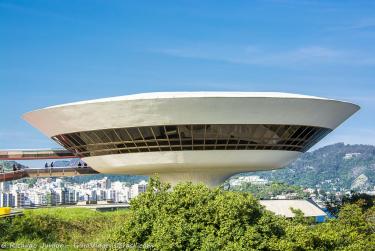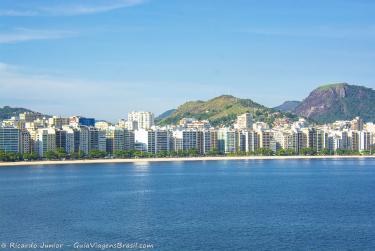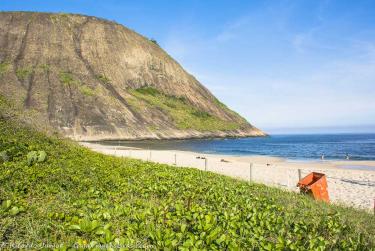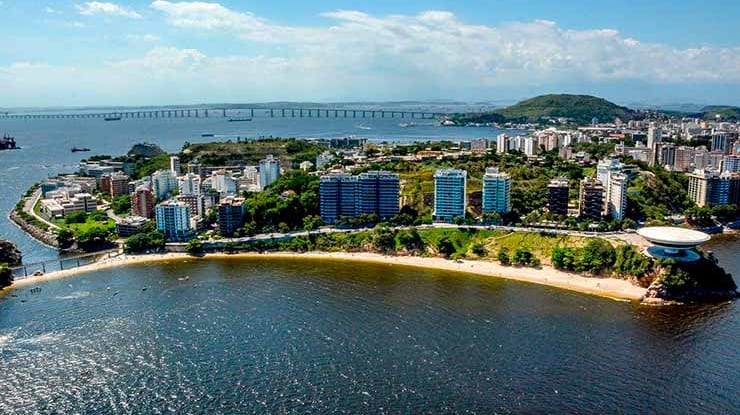On this page, you will find:
See too:
Just outside Rio de Janeiro, Niterói is no less beautiful than the capital. Less busy and just as interesting as the wonderful city, it brings together outdoor and cultural attractions.
Among the outdoor tours, the beaches stand out, which attract attention because they are oceanic, that is, open sea. The view from the beaches reveals Rio de Janeiro’s tourist attractions such as Guanabara Bay and Sugarloaf Mountain. In total, there are 11 km of beach that are divided between: urban ones in Guanabara Bay with countless shacks and located on busy avenues with wide restaurant options and deserted ones bathed by the privileged oceanic region perfect for surfing or relaxing. The urban beaches that stand out are São Francisco and Charitas beaches, while the most preserved are Praia do Sossego, Piratininga and Itacoatiara surrounded by hills and native vegetation.
To escape the coast for a bit, visit the Fish Market and enjoy the delicious dishes served there and snacks sold. To enjoy sophisticated dishes, visit the restaurants on the waterfront of São Francisco and on Rua do Nóbrega, a reference when it comes to national and international gastronomic establishments. Just like the countless variety of restaurants and beach huts, so are the accommodation options. There are great suggestions for luxury hotels or simple inns that allow for a peaceful and well-deserved stay in Niterói.
Viewpoints such as Parque da Cidade and the fortresses of Santa Cruz and São Luís are perfect options for having exclusive and panoramic views that reveal all the beaches, Sugarloaf Mountain, Guanabara Bay and the Rio-Niterói Bridge. From there, you can take beautiful photos. At the same time, in the forts it is possible to appreciate the preserved architecture and a tour between cannons and old cells. In Parque da Cidade it is possible to have interesting moments of leisure with the family or practice hang gliding. In terms of culture, Niterói is not far behind, it houses the Museum of Contemporary Art in a building designed by Niemeyer and the Ingá Museum with exhibitions of works by 20th century artists. To go back to the city’s history, it is worth visiting Solar do Jambeiro, an old mansion with Portuguese features and the Basilica of Nossa Senhora Auxiliadora.
No matter how much all eyes turn to the capital, Niterói cannot be overlooked.
The city right next door is quite a place to enjoy. Less crowded than Rio, it has beautiful beaches to contemplate nature, take a bath, surf, enjoy the lively kiosks or just lie down and relax on the more remote beaches.
Cultural and historical alternatives are also found in museums, fortresses, churches and mansions that retell the history of the city that was once the state capital. Enjoy your tours calmly, as the city has interesting accommodation options that are a great excuse to take a break.
Niemeyer Path

Photo of the Contemporary Art Museum, in Niterói, RJ
Photo Credit: © Ricardo Junior Fotografias.com.br
In addition to the MAC, designed by Oscar Niemeyer, other modern buildings can be found in the city such as the Popular Theater, the Petrobrás Cinema Museum, the Oscar Niemeyer Foundation and the panoramic tower. Most are not yet open to the public.
See the gallery of Niterói Contemporary Art Museum
Basilica of Our Lady Help of Christians
Salesian priests built this beautiful church in the past. The facade and imposing towers are in the best Gothic style and the internal space is simple. One of the largest pipe organs in Latin America is protected there. It is on Rua Santa Rosa.
city’s park
The park houses a space with a snack bar, craft stores and for adventurers who practice hang gliding. The viewpoint of this park is the main attraction. The view allows you to observe all the beaches, Guanabara Bay, Rio-Niterói Bridge and Sugarloaf Mountain. It is on Estrada da Viração.
Although the capital with its beautiful beaches is right next door, Niterói has unique beaches that are an extension of the beauties found in Rio. The so-called oceanic beaches (open sea) are found here. Most of the beaches are full of kiosks and have strong waters that are good for surfing.
In some others, calmer stretches of natural pool allow for peaceful bathing in the surrounding rocks.
Icaraí Beach

Photo of Praia Icaraí, in Niterói, RJ
Photo Credit: © Ricardo Junior Fotografias.com.br
This extensive beach has a wide strip of sand suitable for walking among the surrounding kiosks and restaurants. Although not recommended for swimming, it offers a beautiful view of Sugarloaf Mountain and Guanabara Bay. Most of the city’s hotels are nearby.
See the photo gallery of Icaraí Beach – Niterói
Camboinhas Beach
It is one of the busiest in the region due to the beauty of the landscape and the clean waters suitable for swimming. The fine, clear sand shares space with kiosks that serve tasty seafood-based snacks. As it is one of the most preserved, it is constantly visited by tourists, especially on weekends. Every late afternoon, a stop is mandatory to enjoy the sunset.
Itacoatiara Beach

Photo of Praia Itacoatiara, RJ
Photo Credit: © Ricardo Junior Fotografias.com.br
This beautiful beach is located within the Serra da Tiririca environmental protection area. The sea is extremely clear and almost transparent blue. The strong waves attract countless surfers. A huge rock called Elephant Rock is one of the attractions of the place. On the coast to the right, a natural pool is formed ensuring relaxing baths.
See the Itacoatiara photo gallery
Charitas Beach
With less tent infrastructure, this beach is constantly visited as it is the starting point for catamarans to Rio de Janeiro. Another attraction is the Charitas Waterway Station designed by Niemeyer.
São Francisco Beach
The calm sea of this beach attracts water sports enthusiasts. The avenue where the beach is located is always crowded with tourists and locals who have fun in the best bars in the city.
Piratininga Beach
In the section that delimits the beginning of the open sea, this beach appeals to two audiences: surfers who practice the sport in Praião, which is 3 km long and has strong waves, and bathers in the section on the right with rocks that form natural pools.
Sossego Beach
The name already highlights the main characteristic of this beach. Don’t worry, it’s the least frequented among the others in Niterói. The sea has good waves and space to splash around to your heart’s content. It is at the southern end of Camboinhas Beach.
Itaipu Beach
This beach stands out for two reasons. One of them is because it is close to a fishing village, which allows for fresh fish in the surrounding restaurants. Another reason is the ruins of the Convent of Santa Teresa, dating from 1716, where the Itaipu Archeology Museum is located, which tell the story of the first natives.
Cultural Attractions
Tours in Niterói appeal to all tourist profiles, as they bring together a bit of art possible through tours at the Museum of Contemporary Art, Caminho Niemeyer and Museu do Ingá; historical tours at Fortaleza de Santa Cruz, Forte São Luís, Basilica Nossa Senhora Auxiliadora and Solar do Jambeiro and contact with nature in Parque da Cidade with the possibility of free flight practices.
Holy Cross Fortress
This fortress once housed famous prisoners such as Bento Gonçalves and Giuseppe Garibaldi, who were heroes of the Farroupilha Revolution. The predominantly guided tours depart from the Santa Barbara Chapel from 1612 and tour grand cannons and old cells. It is on the General Eurico Gaspar Dutra road.
Museum of Contemporary Art
This modern museum was designed by Oscar Niemeyer in the 90s. Impressive for its grandeur and flying saucer shape, it has a cylinder-shaped base measuring 9 meters in diameter.
The second floor of the museum has large windows that reveal a unique view of the sea. The museum’s collection includes works by contemporary artists such as Jorge Guinle and Lygia Clark and curious sculptures. It is located at the Boa Viagem Viewpoint.
Fort São Luís
This fort is 230 meters high on the top of a hill and therefore offers an incredible panoramic view. Guided tours take you on a tour of galleries, tunnels and former soldiers’ houses. The visit lasts around 40 minutes. It is located in Al. Mal. Pessoa Leal.
Inga Museum
The 1860 building was once the headquarters of the Rio de Janeiro government. Today it houses works by 20th century artists and some unknown paintings by Tarsila do Amaral, Iberê Camargo, Di Cavalcanti, Volpi, Guignard and Portinari. It is on Rua Presidente Pedreira.
Solar do Jambeiro
This old and classic mansion with cherry wood floors also has traditional Portuguese tiles. What draws the most attention is the immense, century-old jambeiro in the garden, which provides good shade. It is on Rua Presidente Domiciano.
Summer is the best time to visit any city in Rio de Janeiro and Niterói is no different. The sun shines brightly throughout most of the season, making it possible to enjoy pleasant walks outdoors and make greater use of the beaches.
Prices in high season are a little steep due to the high number of tourists arriving in the region, so if your goal is to spend less, travel in other seasons.
By airplane:
The Antônio Carlos Jobim international airport and the Santos Dumont national airport in Rio de Janeiro are the closest to Niterói. From there, take a car, bus or ferry to the city.
By car:
Leaving Rio de Janeiro, follow the BR-101 until you reach Niterói, which is only 21 km away. Crossing the famous Rio-Niterói bridge signals arrival in the city.
By bus:
Daily buses from various companies leave from Rio bus station to Niterói.
Ferry: The ferry crossing is one of the most used means by residents who travel to Niterói daily. It’s the simplest way to get there. Boats depart from Estação das Barcas in Praça XV in Rio every 20 minutes. The journey lasts 20 to 40 minutes and passes through Guanabara Bay surrounded by mountains.
Distance: Rio de Janeiro – 21 km / Maricá – 50 km / Petrópolis – 81 km / Nova Friburgo – 128 km / Cabo Frio – 146 km / Campos dos Goytacazes – 260 km.
Did you like it? Share this article with your friends!





